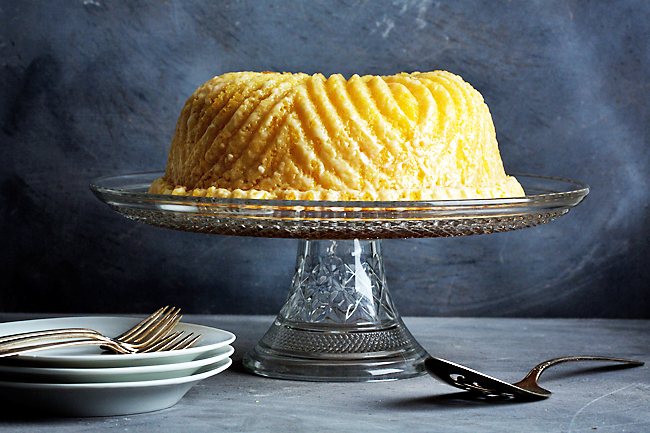LIFE+STYLE- FOOD: CAKES – Cracking the Bundt code
Meyer Lemon Buttermilk Bundt Cake 12 to 16 servings
.
.
IN ANY compendium of foods that serve a crowd, the Bundt cake is a star.
It is pretty, its number of slices can be stretched and it holds for days under cover, all of which makes it ideal for a house full of company or for carrying to a cake-worthy occasion.
The Bundt was not always so ubiquitous.
In 1966, Pillsbury Bake-Off judges awarded second place to a dessert called the Tunnel of Fudge Cake. Moist, chocolate and produced in a Bundt pan, it magically created a thick ribbon of dark chocolate as it baked.
Not only was this cake a forerunner to millions of molten lava cakes served in the intervening decades, but it made the Bundt pan a must-have for home bakers.
Nordicware, from Minnesota-don’t-you-know, has been in the cast aluminium Bundt pan business since the early 1950s.
A modern twist on the kugelhopf pan, Bundt pans weigh in at nearly two pounds and are available in 10- and 15-cup sizes, as well as mini-Bundts.
A pan with a 10-cup capacity will serve 12 to 16. The Bavaria Bundt I used for the accompanying recipe has deep crevices and design details and has been in my cupboard for at least 20 years. But it has mostly been gathering dust.
Why? A chocolate-filled chocolate cake can be splendid. I have baked Bundts before – but rarely, because I could never count on the cake coming out in one piece.
Left with bits still attached to those adorable crevices and pleats, I couldn’t show off said cake on my footed cake server. That chunk nibbled out of the side meant that I had to serve it already sliced – which was not the way to a showstopper dessert.
I was determined to crack the Bundt code, and, after several attempts, I have.
Let’s start with getting the cake out of the pan. Of course, I tried non-stick sprays, which didn’t work at all. I tried coating the pan with butter, dusting the buttered pan with flour and dusting a shortening-coated pan with flour – all without consistent results.
At times like this, a food writer reaches out. She asks everyone she knows if they’ve ever made a Bundt cake and, if so, if they know how to get the cake out of the pan.
One friend, who during her teen years held a summer job at a camp, recalled this simple solution used by the camp’s baker: Make a paste of shortening and flour.
This, dear readers, was the answer.
Use your fingers to carefully work the paste into every little cranny, then go back over the surface, removing any excess. It’s a miracle; invert the cooled cake and it slips out. The pan lifts up to expose every detail, exquisitely defined.
My bakes were inconsistent until I remembered Edna Lewis’s recipe for poundcake that starts in a cold oven. The heat is increased slowly over the course of an hour’s bake – a solution that proved perfect for my cake as well.
It emerged from the pan shot through with tiny holes, all the better to soak up the glaze, but no large gaping air bubbles in the centre, and no humps, bumps or cracks.
Once I worked out the baking logistics, I became obsessed with the idea of a Meyer lemon Bundt with a thick ribbon of Meyer lemon curd: a Tunnel of Lemon, if you will.
I added lemon curd to the batter, layered the batter and lemon curd and even plopped curd on the top of the batter to see whether the custard would find its way to the centre of the cake.
Each time, the curd disappeared, absorbed into the cake, leaving no trace.
A chat with an unlikely source (my manicurist) is what finally uncovered the answer: Stabilising the curd with cream cheese made a tunnel of lemony love in the middle of this dreamy, citrusy crumb.
And so what I offer you, dear readers, is a cake that is not hard to make.
A glorious Bundt can be on your cake stand with a reasonable amount of effort, whether you make your own lemon curd or not.
Bake a cake that embraces the Meyer lemon, in season for only a little while. Bring it to the office for a coffee break (remember those?), reward the kids with something bright for after-school snacking or carry it to your next gathering for a downright dazzling dessert. – Text & Photo by The Washington Post

Meyer Lemon Buttermilk Bundt Cake 12 to 16 servings
THIS cake is tangy, tart, moist and dense, with a bright yellow, creamy swirl of Meyer lemon curd throughout.
And it’s generously coated with a citrus glaze.
You’ll need a Bundt pan with a capacity of 10 cups.
The method of coating the pan used in this recipe should ensure a successful extraction, but even if it doesn’t and the cake comes out in less than one complete piece, you can use it to make a trifle.
MAKE AHEAD: The cake can be stored under cover at room temperature for up to three days.
Ingredients
For the filling
1/2 cup Meyer Lemon Curd 1/2 cup cream cheese, cubed, at room temperature
For the cake
One tablespoon solid shortening
Three-and-a-quarter cups plus one tablespoon flour
One teaspoon baking powder
One teaspoon baking soda
1/2 teaspoon kosher salt
12 tablespoons unsalted butter, at a cool room temperature
One-and-a-half cups granulated sugar
Three large eggs
Two tablespoons finely grated zest and 1/4 cup juice from two Meyer lemons
Two cups regular or low-fat buttermilk
For the glaze
Two cups confectioners’ sugar
Two to three tablespoons fresh Meyer lemon juice
Steps
For the filling
Whisk together the Meyer Lemon Curd and cream cheese until smooth, with no white streaks.
For the cake
Combine the shortening and one tablespoon of flour in a small bowl, to create a paste. Use your fingers or a paper towel to generously coat the inside of the Bundt pan with the paste, systematically working it into each crevice. Aim to evenly cover all the surfaces, including the centre tube and the uppermost edges, because the baked cake will fill the entire pan. Get rid of any excess paste.
Whisk together the remaining flour, baking powder, baking soda and salt in a separate bowl.
Place the cool butter in the bowl of a stand mixer or handheld electric mixer; beat on low speed until the butter is smooth, waxy and shiny on the sides of the bowl. Add the granulated sugar; increase the speed to medium and beat until well incorporated. Stop to scrape down the bowl. Add the eggs one at a time, spooning in one tablespoon of the flour mixture between the second and third eggs; this will help to reduce lumps in the batter. Stop to scrape down the bowl, then add the zest and juice, beating on low speed.
Add one-third of the flour mixture to the egg mixture, beating on low speed. Add one cup of the buttermilk and beat on low speed until well incorporated. Stop to scrape the bowl and beaters. Add the remaining flour and buttermilk, alternately, in three additions, beating on low speed after each one. Once the batter is almost smooth, stop the mixer, remove its bowl, scrape the paddle/beaters and bowl and stir the batter gently to combine all the ingredients.
Spoon half the batter into the Bundt pan. Spoon the Meyer Lemon Curd mixture over the batter, then top with the remaining cake batter, making sure to cover the filling completely. Gently rap the pan on the counter to deflate any air bubbles, then place the pan in the cold oven (middle rack). Turn on the oven to 300 degrees; bake for 20 minutes, then increase the temperature to 325 degrees and bake another 20 minutes. Finally, increase the temperature to 350 degrees and bake for 30 minutes, until the cake is just pulling away from the edges of the pan. Cool completely on a wire rack, in the pan and without inverting, for one hour.
Set a rack over a baking sheet. Invert the cooled cake pan over the rack and tap on the top of the pan. Take a deep breath and lift straight up. If some parts of the cake remain in the pan, see if a toothpick will help pry them loose, then reconstruct the cake without shame.
For the glaze
Whisk together the confectioners’ sugar and two tablespoons of the lemon juice in a bowl, until very smooth. As needed, use more lemon juice, but keep the consistency thick and opaque. Spoon this glaze over the cake, coating the entire surface and letting it flow down the sides to fill all the nooks and crevices.
The glaze helps keep the cake both moist and fresh, so be generous and use all of it. Let the glaze set, about 20 minutes, then use two wide spatulas or a cake lifter to transfer the cake to platter or cake stand.
Nutrition | Per serving (based on 16): 370 calories, 6g protein, 55g carbohydrates, 14g fat, 8g saturated fat, 85mg cholesterol, 190mg sodium, 0g dietary fibre, 35g sugar …. / BORNEO Bulletin / | Cathy Barrow |
.
NOTE : All photographs, news, editorials, opinions, information, data, others have been taken from the Internet ..aseanews.net | [email protected] | For comments, Email to : Al Bulario | [email protected] | Contributor |










